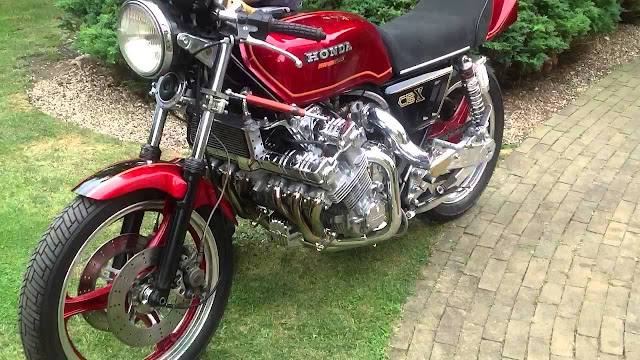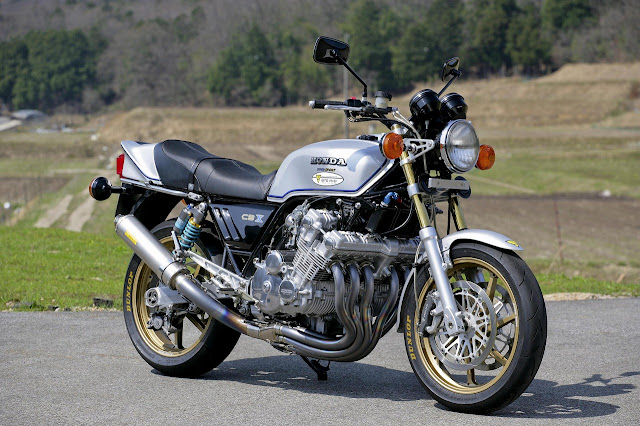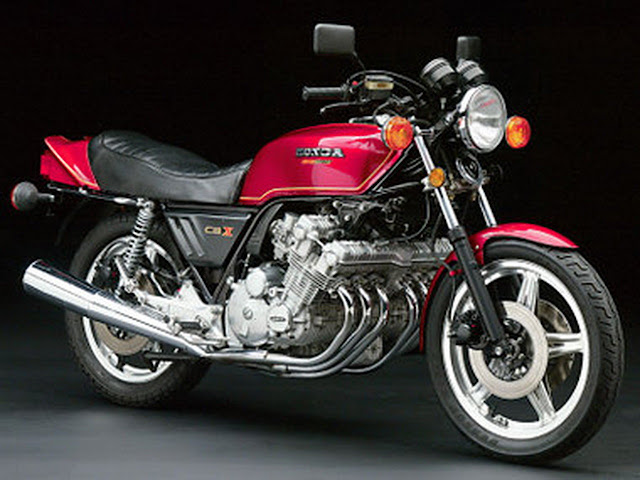Honda CBX1000
The CBX1000 had only two silencers, but even so the six-cylinder engine combined with neat styling to give the Honda a dramatic look from almost every angle. Compared to the large and muscular motor, the bike’s thin front forks, narrow tyres and small brake discs seem insubstantial, although they were top-class components in 1978.
Honda’s mighty six-cylinder CBX1000 was the superbike that appeared to have it fL uA all. Its 24-valve engine produced a phenomenal 105bhp. making the CBX the most powerful production motorcycle on the road in 1978. Its searing speed was backed by remarkable smoothness and technical sophistication, even by Honda’s high standards.
The Six was a handsome machine that had a pure-bred sporting image. It came with a sense of history, having been inspired by Honda’s famous multi-cylinder racebikes of the mid-1960s. And its chassis was excellent, too, boosted by innovative use of weight-reducing materials.
Years after the bike’s launch, it still inspires great loyalty from a devoted band of enthusiasts, and respect from most people who have ridden one. It remains a landmark machine, having combined style, technology and performance in a way arguably not seen before or since from Japan. Yet ironically the Six was a short-lived sales failure when new.
Multi-cylinder heritage
The CBX 1000 was shaped by project leader Shoichiro Irimajiri, who as a young engineer in the 1960s had worked to create Honda’s high-revving multi-cylinder grand prix bikes raced by Mike Hailwood, Luigi Taveri and others. The racers provided inspiration for the CBX’s cylinder head, with its 24 tiny valves. The exhaust camshaft was hollow to save weight. The CBX trod new ground for a standard machine by using lightweight magnesium for several engine covers.
Irimajiri got round the potential width problem of a six-cylinder motor with a jackshaft, above the gearbox, which drove the alternator and ignition system. This allowed the 1047cc motor to be remarkably narrow at its base. Legroom was provided for the rider by tilting the cylinders forward by 33 degrees, and by angling the six carbs inwards in two pairs of three.
Honda created the CBX as a no-compromise sports bike. Its styling was dramatic, emphasized by the way in which the wide engine, which being air-cooled required no radiator, was suspended by the tubular steel frame. The absence of downtubes added to the visual impact.
Straight-line performance was awesome, combining smoothness with the most ferocious acceleration yet seen from a production bike.
Below 6000rpm the CBX responded crisply but without great force. Above that figure it came alive, surging towards its I35mph (217km/h) top-speed with a memorable, high-pitched howl from its exhaust. Most riders who rode the big six-cylinder machine were captivated by its unique blend of speed and charisma.
Its chassis worked, too. The CBX had good quality suspension, plus an efficient twin-disc front brake. Weight was kept to a minimum by use of aluminium handlebars, plastic mudguards and magnesium engine covers. Although the Honda still weighed a substantial 572lb (259kg), and could not match the composure of Suzuki’s new GSIOOO four, it handled well for such a big bike.
But for all its pace and panache, the CBX sold very poorly, especially in the vital (and touring oriented) American market. Part of the reason was simply that the Six cost far more than its less exotic rivals. In some markets it was 50 per cent more expensive than equivalent fours, yet offered no real advantage in terms of pure performance.
After a 1981 redesign that created the fully- faired CBX1000B, an attempt to add appeal for long-distance riders, the Six was dropped from the range. Honda’s gamble had failed. But the CBX had given the firm’s image a considerable boost. As one star-struck tester had put it in 1978, ‘the Six is one of those rare machines that will never, ever be forgotten.' As long as fast bikes are ridden and admired, there is absolutely no danger of that.
The CBX frame had no front dow ntubes to spoil the dramatic view of the six-cylinder powerplant. fitted here with Honda's crash-bars. The 24-valve unit's I05bhp output gave fierce acceleration and was very smooth and reliable.
Specification Honda C8X1000 (1978)
- Engine Air-cooled dohc 24-valve six
- Capacity 1047cc (64.5 x 53.4mm)
- Maximum power 105bhp @ 9000rpm
- Transmission Five-speed, chain final drive
- Frame Tubular steel
- Suspension Telescopic front; twin shocks rear
- Brakes Twin discs front; disc rear
- Weight 572lb (259kg) wet
- Top speed 135mph (217km/h)
























0 comments: